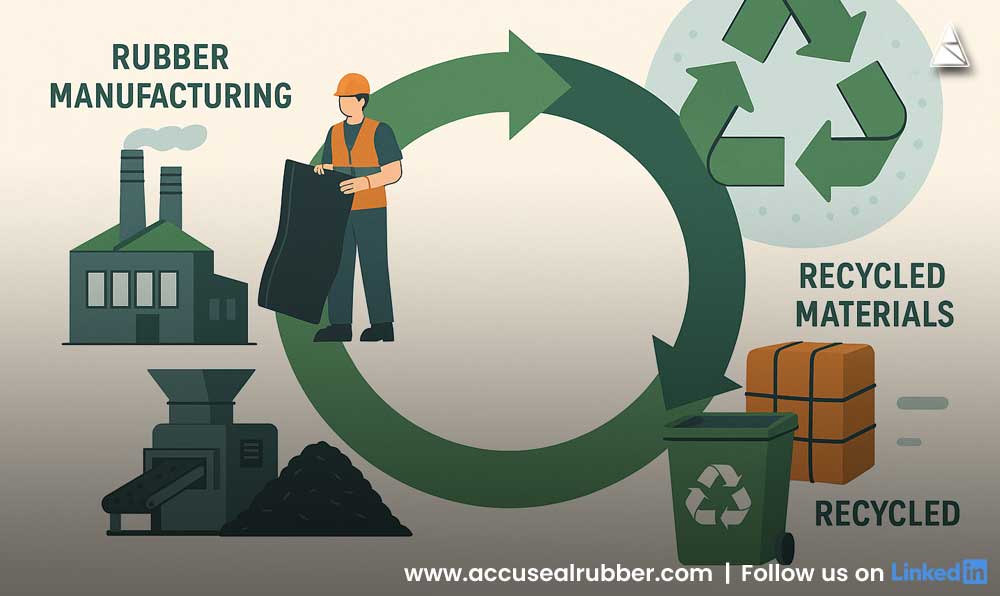When we think of sustainability, rubber is rarely the first material that comes to mind. Yet, in today’s world of escalating climate concerns and resource scarcity, rubber manufacturing is playing an unexpectedly powerful role in driving the shift toward a circular economy. From recycled tires transformed into roadways to industrial seals made from reclaimed materials, rubber is no longer just a disposable commodity—it’s a critical component in reducing environmental impact and creating a more regenerative production cycle. As industries worldwide look to close the loop and minimize waste, rubber manufacturing is proving to be both innovative and essential.
Understanding Rubber Manufacturing and the Circular Economy
What is a circular economy, and how is it different from a linear one?
A circular economy is a regenerative system where materials and products are reused, repaired, refurbished, and recycled to extend their life cycle. It contrasts with the traditional linear model—take, make, dispose—which results in large volumes of waste and resource depletion. In a circular economy, waste is treated as a resource, and value is retained as long as possible. Rubber manufacturing, when designed within this model, focuses on reducing environmental footprints by transforming used rubber into new, valuable products.
How does rubber manufacturing align with circular economy principles?
Rubber manufacturing aligns with circular economy goals through:
Recycling: Post-consumer rubber, such as tires and seals, is collected, shredded, and reused in new applications.
Reprocessing: Scrap rubber from production is reintegrated into the manufacturing line.
Design Innovation: Products are developed for longer life spans and easier disassembly or recycling.
Resource Efficiency: Optimized processes reduce the need for raw material extraction.
These strategies reduce dependence on virgin rubber and help curb environmental degradation.
What are the key environmental benefits of adopting circular rubber manufacturing?
Circular rubber practices deliver multiple environmental benefits:
Waste Reduction: Diverting rubber waste from landfills significantly cuts down on environmental pollution.
Carbon Emissions Savings: Reusing and recycling rubber requires less energy than producing new material, lowering emissions.
Natural Resource Conservation: Limiting the need for fresh rubber extraction preserves ecosystems and biodiversity.
Pollution Mitigation: Recycling reduces the harmful effects of rubber incineration, such as air toxins and soil contamination.
By embracing circularity, the rubber industry contributes to cleaner production and a healthier planet.
What are some common circular rubber products?
Several everyday and industrial products are created using recycled rubber:
Playground Tiles: Made from ground rubber tires for safety and durability.
Retread Tires: Extend the usable life of tire casings with new tread.
Rubber Mulch: Used in landscaping and gardening.
Industrial Rubber Mats: Produced from reclaimed rubber for workspaces and machinery floors.
Seals and Gaskets: Some manufacturers now use recycled compounds for high-performance applications.
These products demonstrate how discarded rubber can be reinvented with functionality and purpose.
What technologies are helping rubber manufacturing go circular?
Innovation is central to circularity. Key technologies include:
Devulcanization: Breaks sulfur crosslinks in vulcanized rubber, enabling material reuse.
Cryogenic Grinding: Rubber is frozen and crushed into fine particles for reintegration into products.
Pyrolysis: Converts rubber waste into fuel and raw materials via thermal decomposition.
3D Printing: Enables precise use of recycled rubber in custom components.
Smart Manufacturing Systems: AI and IoT help optimize resource use and minimize scrap.
These advancements are making it easier, cleaner, and more cost-effective to recycle rubber at scale.
What obstacles does the rubber industry face in embracing circular practices?
Despite growing momentum, several challenges exist:
Economic Viability: Recycled rubber must remain competitively priced against virgin materials.
Processing Limitations: Not all rubber types are easily recyclable due to additives or mixed material composition.
Lack of Infrastructure: Collection and processing systems are not yet universally available.
Perception Issues: Some sectors still view recycled rubber as inferior in performance.
Addressing these barriers requires continued innovation, investment, and consumer education.
How does rubber contribute to industrial circularity across sectors?
Rubber’s flexibility and resilience make it vital in various industries:
Automotive: Retreaded tires and recycled rubber gaskets reduce waste and costs.
Construction: Rubber-modified asphalt and vibration pads enhance durability.
Oil & Gas: Recycled high-pressure seals reduce both material waste and downtime.
Electronics: Shock-absorbing rubber components are increasingly made from reclaimed sources.
Rubber not only supports sustainable design but also enhances product performance and life cycle in industrial settings.
Are there government policies supporting circular rubber manufacturing?
Yes, many policies are boosting the adoption of circular rubber practices:
Recycling Mandates: Regulations require tire recycling in several countries.
Producer Responsibility Laws: Manufacturers are accountable for end-of-life product management.
Green Public Procurement: Governments favor suppliers with eco-friendly materials.
Sustainability Certifications: Standards such as ISO 14001 encourage environmental accountability.
Such frameworks are crucial in incentivizing responsible manufacturing practices.
How can businesses and consumers help drive circularity in rubber usage?
Businesses can:
Design rubber products for disassembly and recycling.
Use recycled rubber in manufacturing.
Partner with recycling and reclamation firms.
Consumers can:
Choose products made with recycled or reclaimed rubber.
Properly dispose of rubber items for recycling.
Support brands with sustainable practices.
Collective action accelerates the transition to a closed-loop rubber economy.
What does the future look like for circular rubber manufacturing?
The future is both promising and innovative:
Bio-Based Rubbers: Renewable materials like dandelion or guayule offer sustainable alternatives.
Closed-Loop Supply Chains: Manufacturers reclaim rubber from their own products for reuse.
Digital Product Passports: Track lifecycle and recyclability of rubber components.
Collaborative Ecosystems: Cross-industry partnerships will drive large-scale circular integration.
As sustainability becomes non-negotiable, rubber manufacturing is poised to be a cornerstone of material circularity.
Conclusion
The rubber industry is rapidly shedding its reputation as a high-waste sector and emerging as a leader in circular economy innovation. From recycling processes and product redesign to technological advancements and regulatory support, the shift toward circularity is transforming rubber manufacturing into a model for sustainable industry.
If you’re seeking a reliable partner that’s already embracing these practices, Accuseal Rubber Inc. is at the forefront. Known for producing high-performance rubber components with a strong emphasis on environmental stewardship, Accuseal stands as a benchmark in combining industrial excellence with circular innovation.

 Nick Parker
Nick Parker